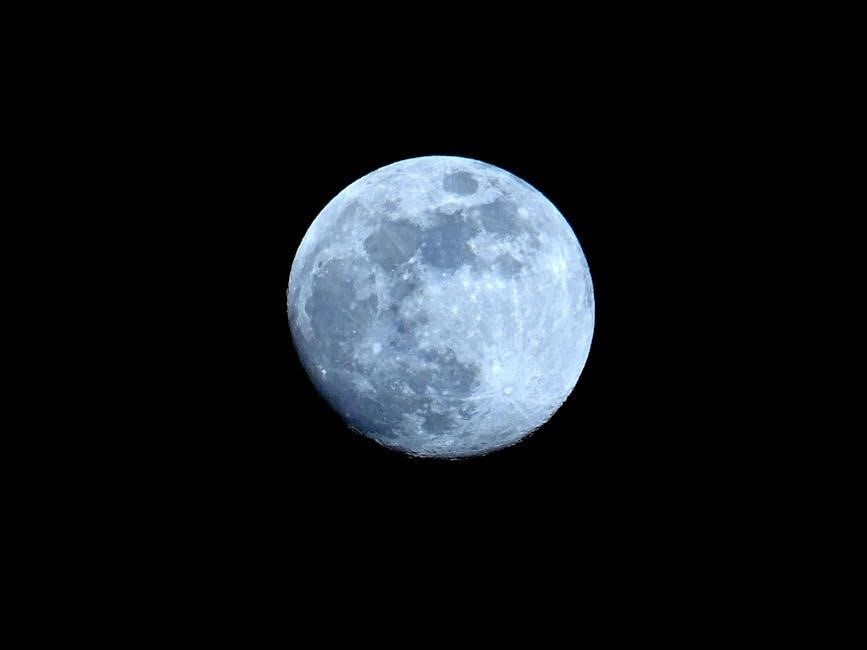The lunar cycle captivates humanity, showcasing the Moon’s transformation as it orbits Earth. Understanding its phases reveals the interplay of sunlight, gravity, and time, shaping our cultural and scientific curiosity.
Overview of the Lunar Cycle
The lunar cycle, lasting approximately 29.5 days, is the time it takes for the Moon to return to the same phase. This period, known as a synodic month, includes eight distinct phases: New Moon, Waxing Crescent, First Quarter, Waxing Gibbous, Full Moon, Waning Gibbous, Last Quarter, and Waning Crescent. These phases occur as the Moon orbits Earth, with the Sun’s light illuminating different portions of its surface. The cycle begins with the New Moon, where the Moon is between the Sun and Earth, and progresses through increasing illumination until the Full Moon, followed by a decrease until the next New Moon. This cyclical pattern is essential for understanding tidal changes, agricultural planning, and cultural traditions tied to lunar observations.

Importance of Understanding Moon Phases
Understanding Moon phases is crucial for various practical applications and cultural insights. Farmers use lunar cycles to plan planting and harvesting, while fishermen rely on tidal patterns influenced by the Moon. The phases also play a significant role in astronomy, helping predict eclipses and celestial events. In education, studying Moon phases enhances children’s understanding of astronomy and natural cycles. Additionally, many cultures have traditions and rituals tied to specific lunar phases, highlighting their historical and spiritual significance. Recognizing the Moon’s phases fosters a deeper connection with nature and our environment, making it a valuable area of study for both scientific and cultural enrichment.
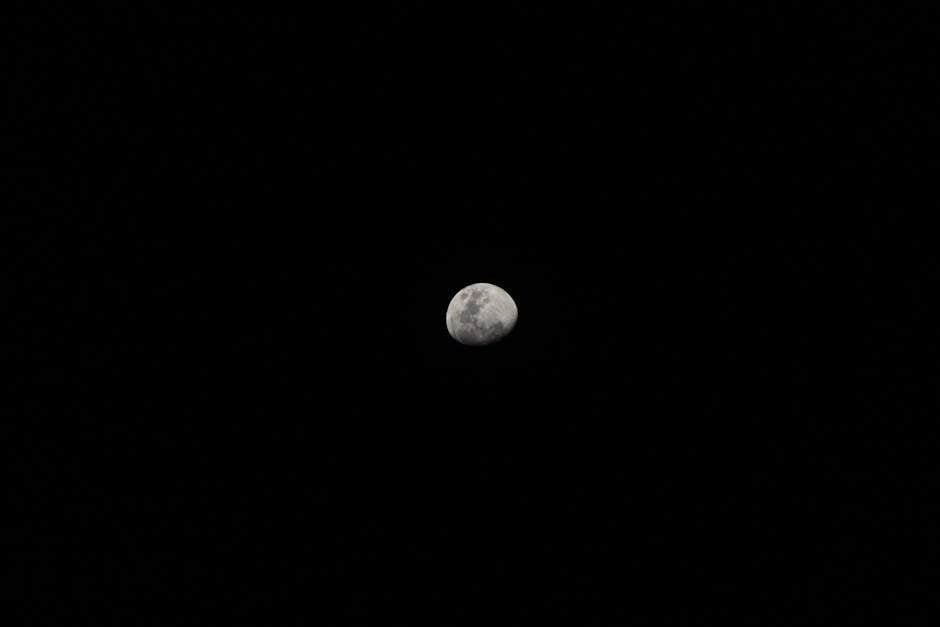
The Lunar Cycle and Its Mechanics
The Moon orbits Earth, completing a cycle every 29.5 days. Its phases result from sunlight interacting with its position relative to Earth and the Sun.
Orbit of the Moon and Earth’s Rotation
The Moon orbits Earth in an elliptical path, completing one full cycle every 27.3 days (sidereal month) but appearing to take 29.5 days (synodic month) due to Earth’s rotation. This difference arises because the synodic month accounts for Earth’s movement around the Sun, making the Moon’s phases align with our calendar. The Moon’s orbit is tilted, preventing eclipses every month, as it often stays above or below Earth’s shadow. Earth’s rotation causes the Moon to rise approximately 50 minutes later each night, making its phases observable from different locations. This gravitational dance between Earth and the Moon regulates tides and stabilizes Earth’s axis, showcasing a harmonious celestial relationship.
The Role of Sunlight in Shaping Moon Phases
The Moon’s phases are directly influenced by the interaction of sunlight with its surface as it orbits Earth. The amount of illuminated surface visible from Earth determines the phase, with sunlight reflecting off the Moon’s surface toward our planet. During the New Moon, the Moon is positioned between the Sun and Earth, making its illuminated side invisible from Earth. As the Moon moves through its orbit, increasing amounts of sunlight become visible, transitioning through phases like Waxing Crescent and First Quarter. Conversely, after the Full Moon, the illuminated portion decreases, leading to Waning Gibbous and other phases. This constant change in sunlight’s visibility is the fundamental driver of the Moon’s phases, creating the ever-changing celestial display we observe.

Primary Phases of the Moon
Primary Moon phases include New Moon, Waxing Crescent, and First Quarter. These phases mark the Moon’s initial growth from darkness to partial illumination, symbolizing new beginnings.
New Moon
The New Moon marks the beginning of the lunar cycle, occurring when the Moon is positioned between the Earth and the Sun. During this phase, the Moon is invisible from Earth as its illuminated side faces entirely toward the Sun. This phase symbolizes renewal and fresh starts, often associated with new beginnings in cultural and astronomical contexts. The New Moon is also a critical point for astronomical events, such as solar eclipses, which can occur during this alignment. In many cultures, the New Moon is celebrated for its symbolic significance, representing opportunities for growth and reflection. It is also a time when the Moon’s gravitational influence on Earth’s tides is at its most balanced, impacting marine life and coastal ecosystems. This phase is deeply rooted in folklore and modern wellness practices, guiding rituals and routines for those attuned to lunar cycles.
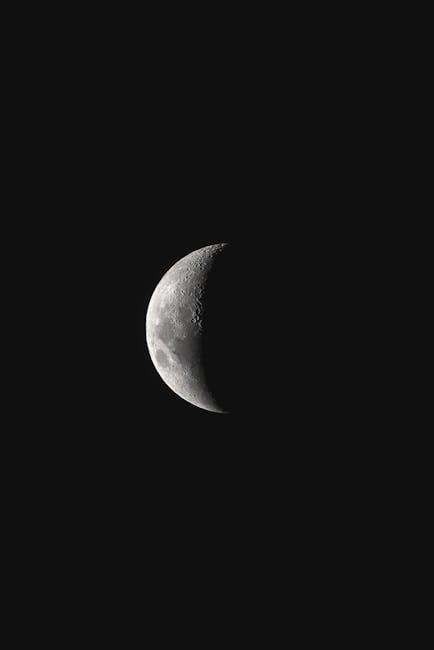
Waxing Crescent
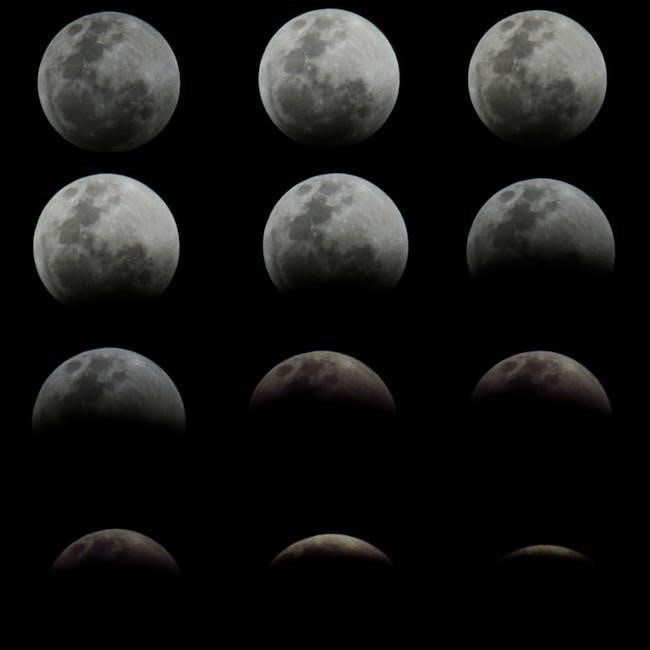
The Waxing Crescent phase occurs after the New Moon, as the Moon begins to appear larger in the sky. This phase is characterized by a growing sliver of light on the Moon’s right side when viewed from Earth. It symbolizes growth and progress, often inspiring new endeavors and heightened creativity. Agriculturally, this phase is ideal for planting seeds, as it is believed to promote robust growth. Culturally, the Waxing Crescent is associated with increasing energy and positivity, influencing rituals and practices aimed at personal development. This phase serves as a visual reminder of transformation and the cyclical nature of life, resonating deeply with both practical and spiritual traditions worldwide.
First Quarter
The First Quarter phase occurs when the Moon has completed one-quarter of its orbit around Earth, appearing half-illuminated from our perspective. This phase is marked by a right angle between the Sun, Earth, and Moon, causing the Moon’s right half to shine brightly. Culturally, this phase symbolizes decision-making and action, often inspiring individuals to evaluate progress and make adjustments. Farmers historically use this phase for pruning or weeding, believing it enhances plant health. The First Quarter also signifies stronger tides due to gravitational pull. This phase is a pivotal moment in the lunar cycle, emphasizing growth, clarity, and strategic planning, making it a significant marker for both practical and symbolic purposes worldwide.

Secondary Phases of the Moon
The secondary phases include the Full Moon, Waning Gibbous, and Last Quarter. These phases mark the Moon’s illumination decreasing, showcasing its gradual transition from full light to partial visibility, highlighting the Moon’s dynamic transformation and its gravitational influence on Earth.
Full Moon

The Full Moon occurs when the entire face of the Moon illuminated by the Sun is visible from Earth. This phase happens approximately every 29.5 days and marks the midpoint of the lunar cycle. During this time, the Moon is on the opposite side of the Earth from the Sun, making it fully reflective. The Full Moon has cultural and astronomical significance, often influencing tides and human activities. It is a key phase for observations and is commonly associated with celestial events like eclipses when the Earth, Moon, and Sun align. The Full Moon’s brightness and prominence make it a popular subject for study and admiration.
Waning Gibbous
The Waning Gibbous phase occurs after the Full Moon, as the Moon begins to appear smaller in the sky. This phase is characterized by the decreasing illumination of the Moon’s surface, with more of its dark side visible from Earth. The term “gibbous” refers to the Moon’s shape, which appears more than half full but not completely illuminated. During this phase, the Moon continues its orbit away from the Full Moon position, gradually reducing the amount of reflected sunlight visible to observers. The Waning Gibbous phase is a transitional period, marking the Moon’s movement toward the Last Quarter and eventually the New Moon. It is a significant phase for studying lunar cycles and their effects on Earth’s tides and natural rhythms.
Last Quarter
The Last Quarter, or Third Quarter, occurs when the Moon is half-illuminated from the right side, signaling the final stages of the waning phase. This phase happens approximately 21.5 days after the New Moon and marks a significant point in the lunar cycle. The Moon appears in the western sky at sunrise, visible throughout the morning, and sets at noon. During this phase, the Moon’s gravitational influence on Earth’s tides is pronounced, causing higher high tides and lower low tides. Culturally, the Last Quarter has been associated with reflection and release, often used in agricultural planning and maritime activities. It serves as a transitional period before the Moon re-enters the New Moon phase, completing its cycle.
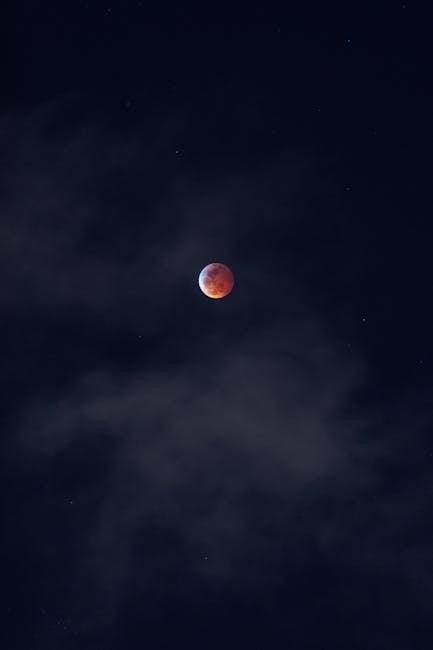
Additional Phases and Transitions
Beyond primary phases, the Moon transitions through intermediate stages like Waxing Gibbous and Waning Crescent. These phases highlight gradual illumination changes, offering deeper insights into lunar dynamics and cultural symbolism.
Waxing Gibbous
The Waxing Gibbous phase occurs after the First Quarter and before the Full Moon, as the Moon continues to illuminate more of its surface. During this stage, over half of the Moon is visible from Earth, but it is not yet fully lit. The term “Gibbous” refers to the Moon’s shape, appearing more rounded and fuller, while “Waxing” indicates that the illuminated area is increasing. This phase is a transitional period where the Moon’s light expands, symbolizing growth and progression. Culturally, it is often associated with abundance and preparation, as the Moon approaches its fullest form. The Waxing Gibbous phase typically lasts for about four to five days, showcasing the dynamic nature of lunar cycles. This phase is also significant in astronomical studies and agricultural planning, as it reflects the Moon’s increasing influence on tides and natural rhythms.
Waning Crescent
The Waning Crescent phase marks the final stage of the lunar cycle, occurring after the Last Quarter and before the New Moon. During this phase, the Moon appears as a thin crescent in the western sky, visible just before sunrise. The illuminated portion decreases as the Moon moves closer to the Sun’s position. This phase symbolizes release, completion, and preparation for renewal. Culturally, it is often associated with introspection and letting go. The Waning Crescent phase lasts for about two to three days, during which the Moon’s light fades, leading to the start of a new cycle. This period is significant in both astronomical observations and cultural practices, reflecting the cyclical nature of time and transformation. The decreasing light also influences Earth’s tides and nocturnal activities, highlighting the Moon’s subtle yet profound impact. Understanding this phase deepens our connection to lunar rhythms and their effects on our world.

Cultural and Historical Significance of Moon Phases
The Moon’s phases have shaped mythology, traditions, and spiritual practices worldwide, influencing agriculture, rituals, and human identity. Its cyclical transformations symbolize renewal and connection to the universe.
Impact on Human Activities and Beliefs
The phases of the Moon have profoundly influenced human culture, traditions, and daily life. Many societies synchronized agricultural cycles with lunar phases, planting and harvesting according to the Moon’s transitions. Fishermen tracked tides linked to the Moon’s gravitational pull, while spiritual practices often aligned with its cycle. The Moon’s phases were also integral to mythology and religious rituals, symbolizing renewal and transformation. In astrology, the Moon’s phases are believed to influence emotions, relationships, and human behavior. Additionally, wellness routines and personal growth practices often follow the lunar cycle, with the new moon representing new beginnings and the full moon signifying release. The Moon’s cultural significance underscores its enduring connection to human life and belief systems.
Practical Applications of Moon Phase Knowledge
Moon phases guide agriculture, tidal predictions, and maritime navigation. Farmers use lunar cycles for planting and harvesting, while fishermen rely on tidal patterns for fishing schedules;
Agriculture, Tides, and Lunar Cycles
The lunar cycle significantly influences agriculture and marine activities. Farmers historically align planting and harvesting with moon phases, believing gravitational effects optimize soil moisture and crop growth. Similarly, fishermen rely on tidal patterns, as the Moon’s gravity causes high and low tides, affecting marine life behavior. The full and new moons typically induce spring tides, while quarter phases bring neap tides. By understanding these rhythms, communities enhance productivity and sustainability. This ancient wisdom continues to guide modern practices, showcasing the Moon’s practical impact on Earth’s natural systems and human endeavors.
The Moon’s phases offer insights into celestial mechanics and cultural traditions. Future exploration may uncover more about lunar influences, guiding scientific and philosophical inquiries into our cosmic neighbor.
Final Thoughts on the Phases of the Moon
The journey through the Moon’s phases reveals a harmonious dance between light, shadow, and gravity. Each phase, from New Moon to Full Moon and beyond, teaches us about the universe’s rhythms. The lunar cycle, spanning 29.5 days, is a natural wonder that has inspired human curiosity and cultural traditions. By understanding these phases, we gain insights into celestial mechanics, tides, and the Earth-Moon-Sun system. The Moon’s transformations remind us of nature’s cyclical beauty and its influence on our emotions and activities. As we continue to explore, the phases of the Moon will remain a timeless source of fascination, guiding both scientific inquiry and personal reflection.
